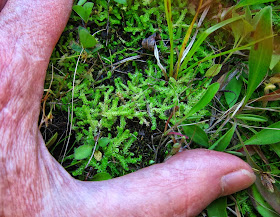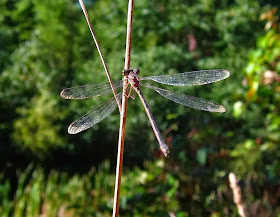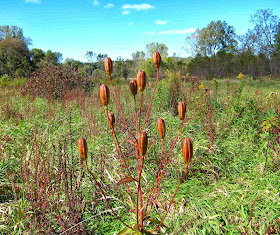Thursday, September 19: The Woodlawn Preserve in Schenectady
I enjoy a hike with my friends in the Thursday Naturalists wherever we may go. But a visit to a pine plains habitat like the Woodlawn Preserve is always a special treat. There are a number of plants we find few other places than here, and we made a special effort to find them all on this sun-warmed day that started so cold we hoped the flowers had not been killed by frost. So far, so good, we discovered, and we hadn't gone more than a few steps along the path when we found our first unusual plant, the Tall Boneset (Eupatorium altissimum), a plant that's found in only a few counties in the entire state.
Our search for multitudes of Fringed Gentian was rewarded promptly, as well, when we came upon hundreds of these cobalt-blue beauties fully opening their lovely fringed petals to the warming sun.
The yellow four-petaled flowers of Seedbox (Ludwigia alternifolia) had long fallen away, but that only made it easier to see the most interesting part of this plant, the perfectly squared-off tiny boxes that contain the flower seeds.
I don't know how we managed to find this tiny patch of Selaginella apoda in all those acres of the preserve, but our friend Ed has a special eye for finding these little fern allies. That's right, a fern ally. Not a moss at all, although it sure looks like one.
Here was a new plant for my life list, Bushy Aster (Symphyotrichum dumosum), and I nearly ignored it, thinking it was just a stunted version of New England Aster. That's another reason why I love going out with this bunch of very knowledgeable friends.
A little Spreadwing Damselfly was warming itself in the brilliant sunshine of this spectacular September day.
Monday, September 23: The Burl Trail along the Kayaderosseras Creek
This coming Wednesday, I'm leading a natural-history class from the Environmental Clearing House of Schenectady (ECOS) on a field trip along the Kayaderosseras Creek near Ballston Spa. So I went over there on Monday to prepare myself for instructing the class. The Burl Trail is easily walkable for folks of most abilities, and it presents a number of features that will be interesting to investigate. The trail starts out following closely along the creek, where we will be able to discuss recent streambank reconfiguration that was done last year to mitigate the effects of flooding. We will also be able to observe the condition of new plantings of native species intended to restore the natural habitat.
The trail eventually leads away from the creek to cross a meadow that is beautifully abloom this week with asters and goldenrods. It will be interesting to observe how these native plants have held their ground against many invasive species like Purple Loosestrife and Japanese Knotweed.
The battle between natives and invasives takes on truly epic proportions along this creek, where some of the biggest, burliest, and most aggressive of our natives have pushed back against the encroachment of the alien invasives. Here we find giant native plants like Pokeweed and Jewelweed shouldering aside the alien Wild Chervil, and the monumental Great Ragweed seems to be daring any interlopers to step foot on its territory. What intruder would dare challenge a ragweed with stalks as big as axe handles, anyway?
Another giant among native flowers is Jerusalem Artichoke (Helianthus tuberosus), one of our latest sunflowers to bloom each year, and certainly one of our tallest. This flower will provide an interesting challenge to key out, using our Newcomb's Wildflower Guides, since it's listed in our book under plants with opposite leaves, and yet we will find that the leaves become alternate on the stalk as they ascend toward the top-blooming flowers.
Chicory is still beautifully in bloom along the creek bank, so we will be able to note how the pistils push their way up through the stamen tubes, bringing pollen along with them, but only opening their stigmas to receive pollen from other plants until they are poised well above their own flower's stamens.
The Jewelweed plants are loaded now with full-to-bursting seed pods, so we will have fun touching the pods and watching them burst open to propel their seeds outward. It's amazing to think that these towering plants are annuals, growing up from seed anew each spring.
If I hold the pod gently in my palm before it bursts, I can capture the seeds in my hand and observe the tightly coiled sprung-back pod. I have peeled the green husk from one seed to display the beautiful robin's-egg blue of its interior. The seeds are deliciously edible, tasting very much like English walnuts.
Two species of native dogwoods crowd along one section of the trail, and we will be able to tell them apart even after their flowers and fruits have fallen. Panicled Dogwood (Cornus racemosa) holds its white berries on brilliantly red pedicels, which remain on the shrub after birds have consumed the berries.
The reddish bark with vertical lenticels is the key to distinguishing Silky Dogwood (Cornus amonum) from other members of its genus. Panicled Dogwood has gray bark, and Red Osier Dogwood has smaller, pinpoint lenticels on even redder bark.
Some flowers can readily be identified by their seed pods, and Canada Lily (Lilium canadense) is one of them, with its whorls of many pods.
Velvetleaf, also known as Indian Mallow or Pie Plant (Abutilon theophrasti), has one of the most distinctive seed pods of all, as sharply crimped and fluted as the crust on the edge of a pie.
I won't ask the class to try to ID this unusual narrow-leaved sunflower, since I myself could not find it in any of my guidebooks. I sent photos to my go-to guy at the New York Flora Association, Steve Young, and he promptly identified it as
Note that this plant is growing at the base of a newly planted tree, its bark still wound with protective fabric. It's quite likely the sunflower hitched a ride to this site with the dirt ball that surrounded the tree. I find the sunflower's name quite misleading, since one of the distinctive features of this particular plant is the absence of large teeth on the narrow leaves.
UPDATE, September 2015: We later determined this sunflower to be NOT Sawtooth Sunflower, but rather MAXIMILIAN SUNFLOWER, also a native of more central parts of the US. In the two years
since I first noticed this single plant growing at the base of a tree, dozens and dozens of this sunflower are now growing at this site. Our concern is that it may turn out to be invasive.
Here's a closer look at the
Tuesday, September 24: Around the Lake at Moreau Lake State Park
Another ECOS group from Schenectady joined me on Tuesday to walk the shore of Moreau Lake, and we couldn't have asked for a lovelier day for strolling the sandy beach and observing the plants that grew there. I should have known better than to lead the group on a complete circuit of the lake, a distance of about three miles, since the walk was advertised as being about two hours in duration. Well, maybe for brisk walkers, but we were proceeding at botanizing speed. But not too many folks complained about spending more time than planned, considering the kind of day it was, not to mention the location.
Not many leaves are turning yet, but a few boughs of a few Red Maples were giving us a preview of the glory to come.
When I lead a group on a nature walk, I seldom take the time to take photos, but I did catch a shot of this pretty sedge with its feathery apricot-colored seed-heads (species unknown to me) that is abundant all along the sandy shore.

Update: Readers of the comments to this post will see that botanist Andrew Gibson has suggested that this is Toothed Flatsedge (Cyperus dentatus), noting the flat shape and scales that extend past one another, which give it a toothed appearance. Thanks, Andrew.
One member of our group called us to come check out this interesting looking plant, and we were really happy to find one of our native grapeferns (Botrychium sp.?), although we couldn't immediately put a species name to it. We did note that its spore stalk was growing separately from its leafy stalk, so maybe that will help us find out its complete name. These are called grapeferns because the spores are borne in tight clusters of tiny balls resembling clusters of grapes.
Update: Pat Rush, one of our group at Moreau, has been researching grapeferns and suggests that this could be Leathery Grapefern (Botrychium multifidum), citing the separate stalks and the lack of indentation on the leaves. When I went on Google to look at images of this plant, I noticed that some sources used the genus name Sceptridium instead of Botrychium. The two names are synonymous.
Of course I led the group to visit the rare Mountain Mint I found last week (as yet unidentified as to variety), and some of us got to see some tiny Late Coralroots that hide in the woods, so small as to be nearly invisible. I was also able to point out how Pitch Pines, which grow along the north shore of the lake, hold on to their cones for years. We could find the baby cones just born this summer as well as yearlings and even older cones still tightly attached to the boughs.
But what a surprise, and not a nice one, to find masses of Red-headed Pine Sawfly larvae completely denuding the Pitch Pine boughs they were clustered on.
I stopped off at the park headquarters to show the park manager photos of this infestation, and he has contacted the park's botanists to determine if pest control needs to be initiated.



























Fantastic! What beauty you wallow in, you certainly have kept the ability for wonderment alive within you! I have just realised that this is what attracts me to your blog, that is what you convey with your photographs. As usual, thank you so much for sharing it all with us.
ReplyDeleteLovely post, Jackie! I believe your mystery sedge is Cyperus dentatus (Toothed Flatsedge). We don't have that in Ohio but I have seen it in its very disjunct populations near Lake Michigan in NW Indiana. Its flat shape and scales extending past one another, giving it a "toothed" appearance are pretty good characters to go on for this species.
ReplyDeletewow, the spider in the sunflower -- breath-taking !
ReplyDeleteand those larvae look scary (looks like they really clean their plate)